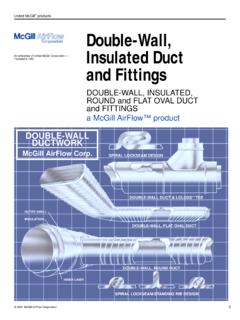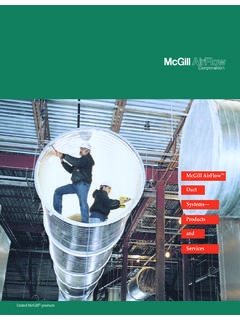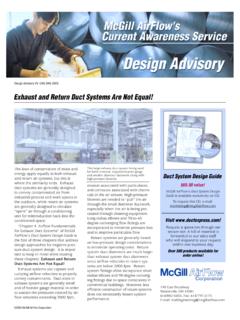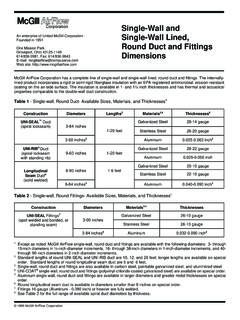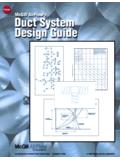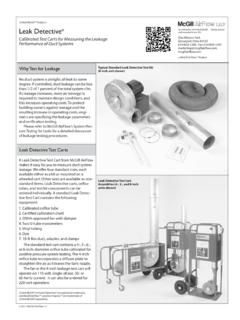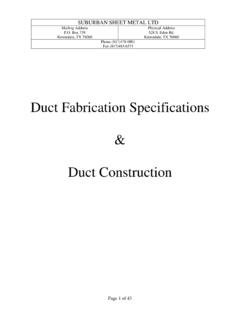Transcription of Rectangular Duct Systems Are Not Cheaper Than …
1 Rectangular duct Systems Are Not Cheaper Than Spiral flat Oval duct Systems !Design Advisory #11: CAS-DA11-2006 How often have engineers and building owners been advised that flat oval duct Systems are as much as 20 percent more expensive in material and installation costs than Rectangular Systems ? This ad-visory was written to dispel this miscon-ceived belief about the savings Rectangular duct offers and to re-educate owners and engineers about the cost-saving benefits of flat oval duct Systems . (Review McGill AirFlow s Technical Bulletin 3-2 system Leakage Comparison for additional infor-mation on this topic.)The following sample duct system com-parison is a project McGill AirFlow ana-lyzed and re-designed for a public library. The library s original system was a 16,385 cubic feet per minute (cfm), 5-inch wg, TSP AHU designed with 3-inch wg, Rectangular supply ductwork between the AHU and the variable-air-volume (VAV ) boxes and 1-inch wg, supply rectangu-lar and round ductwork from the VAV boxes to the diffusers.
2 The return duct system was also 1-inch wg Rectangular . An alternate spiral flat oval duct system was also evaluated, and complete take-off and pricing was done for both ductwork Systems by pressure class established in accordance with 1995 SMACNA HVAC duct Construction Standards. For the Rectangular duct , McGill AirFlow designed the system with TDC joint con-nectors and external angle for intermedi-ate reinforcement. The equivalent flat oval system was designed with McGill AirFlow s Uni-Flange light-gauge con-nectors (rated as a T25 reinforcement) for joints and external angle for intermediate reinforcement. Table 1 shows the results of the material price simple price comparison supports what McGill AirFlow has told the in-dustry for over 50 years, which is that flat oval ductwork is not more expensive than Rectangular . The advent of light-gauge connectors has eliminated the installation problems associated with slip-fit con-nections for flat oval and slip-and-drive for Rectangular .
3 Using flat oval duct for the sample system resulted in 30 percent fewer joints than Rectangular due to flat oval s availability in 12-foot standard lengths. That is 46 percent less lineal feet of joint perimeter to be sealed. flat oval may require a heavier gauge than rect-angular of equal size, but with a shorter flat span, it requires less reinforcement, 72 percent less in this case. The reinforcement of ductwork is a major contributor to the material and labor costs of duct system installation. Rectangular duct has more flat surface area needing reinforcement than flat oval duct , because Rectangular has no design features that increase its rigidity. Spiral flat oval, on the other hand, has a spiral lockseam every six inches and rounded sides that minimize flat surface area, re-sulting in less reinforcement than rectan-gular for a given gauge. It is these design and construction features, along with the ease of installation, that make spiral flat oval duct Systems economically an example, refer to the sample duct system comparison and determine the reinforcement required for the 24- x 72-inch Rectangular duct that is just down-stream of the fan.
4 Table 2-18 (3-inch wg) of the 2005 SMACNA HVAC duct Construction Standards, shows the duct would be constructed of either 16-gauge, 5-foot long TDC duct with 2- x 2- x -inch angle reinforcement at each joint; or 20-gauge, 5-foot long TDC duct with 2- x 2- x -inch angle reinforcement at each joint, and a 2 - x 2 - x -inch angle at the mid-panel every 2 1: Rectangular vs. flat Oval duct system Price Comparison RectangularFlat OvalFlat Oval SavingsAverage Gauge2624 flat Oval 1-gauge heavierDuct Length (ft)1,8751,884 Nearly EqualSurface Area (sq ft)9,7998,814 flat Oval 10% lessNumber of Joints487345 flat Oval 30% lessJoint Perimeter (ft)2,1461,152 flat Oval 46% lessConnector TypeTDCUni-Flange Nearly EqualIntermediate Reinforcement7421 flat Oval 72% lessWeight (lbs)20,95220,551 Nearly EqualPrice*$69,691$64,619 flat Oval 7% less*McGill AirFlow pricing without discounting. 2006 McGill AirFlow LLCThe equivalent flat oval duct size for the sample system is 24- x 77-inches.
5 Therefore Table 3-15 states that 18-gauge construction is to be used. However, paragraph states that the Reinforcement for the flat sides of oval duct shall be the same size and spac-ing interval as specified for Rectangular . The flat side is 77 inches minus 24 inches, or 53 inches, compared with the 72 inches for Rectangular . Table 2-4 (3-inch wg) shows that a standard 12-foot length of 16-gauge spiral flat oval duct requires a 2 - x 2 - x -inch angle reinforcement every 6 feet whereas a 22-gauge spiral flat oval duct requires a 2- x 2- x -inch angle every 3 feet. Spiral flat oval duct material requires less angle reinforcement because of its greater rigidity. This is best shown in the system comparison where the spiral flat oval duct requires 72 percent less reinforcement than that of the Rectangular duct , which results in less joint perimeter to seal and a quicker installation. flat oval is less expensive to shown in the sample duct system comparison, the overall material cost of the flat oval system is relatively equal to the Rectangular system .
6 Now, examine the installation costs. One could possibly prove that a flat oval, slip-fit system is more expensive than a Rectangular slip-and-drive system , but not so when comparing a flat oval system using the T25 rated Uni-Flange connector to a Rectangular system using a T25 TDC connector. For ease of comparison assume that gasketing and connecting TDC and Uni-Flange joints are equal. The fact remains that it will take far more time to install and seal a Rectangular system hav-ing more joints and reinforcement than a comparable flat oval duct system ; 30 percent more joints and 72 percent more reinforcement in the case of this sample duct system comparison. Basically, the field labor required to install any duct system boils down to the number of joints that have to be installed, the lineal feet of joints that have to be sealed, and the number of reinforcements that have to be attached. The TDC and Uni-Flange connectors usually arrive at the job site already installed on the duct and are part of the material cost.
7 The sample Rectangular system has 46 percent more lineal feet of joint and 72 percent more reinforcement than the flat oval system . Those connector Systems should allow for simple gasketing and bolting of flanges to complete the installation. More often than not, the Rectangular duct system will require additional corner joint sealing, especially for meeting allowable leakage specifications less than leakage class 6, the lowest economically obtain-able for Rectangular duct according to SMACNA. The flat oval duct system using a T25 rated Uni-Flange type connector should not require additional sealing of the joint, and when the instal-lation is complete, should leak no more than of 1 percent of system examine these facts carefully. Rectangular duct Systems are not Cheaper than spiral flat oval Systems when mate-rial and installation costs are considered. Technical Bulletin 3-2, system Leakage Comparison, demonstrates that operat-ing costs need to be considered as well.
8 The belief that Rectangular duct Systems are Cheaper than flat oval Systems is an apparent misconception. In this era of increasing energy costs, the designers of HVAC duct Systems need to evaluate and compare the overall benefits of spiral duct Systems . For more information regard-ing the benefits of round and flat oval Systems , please contact McGill East Broadway Westerville, OH 43081 614/882-3328, Fax: 614/882-3337 E-mail: Web site: 2006 McGill AirFlow LLCForm No.: CAS DA11 11/06
